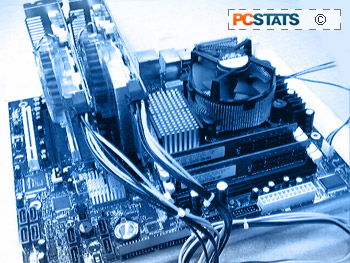The one thing that has propped up AMD for the longest time was wide support for dual videocard gaming - both nVIDIA SLI and AMD CrossFire technology. For Intel users who wanted to run dual videocards, there was no real option for the longest time.
 That was eventually
sorted out when Intel added support for dual videocards (ATI
CrossFire) to its P965 Express chipset. A few Intel Edition nVIDIA nForce 590SLI
motherboards also brought SLI to the Intel platform, but they weren't released in very significant volumes. That Intel Edition nVidia chipset seemed to be EOL'ed rather quickly too.
That was eventually
sorted out when Intel added support for dual videocards (ATI
CrossFire) to its P965 Express chipset. A few Intel Edition nVIDIA nForce 590SLI
motherboards also brought SLI to the Intel platform, but they weren't released in very significant volumes. That Intel Edition nVidia chipset seemed to be EOL'ed rather quickly too.
The situation is much better for gamers looking to run
dual videocards with a Core 2 Duo processor nowadays. nVidia's nForce 680i/650i series
motherboards are readily available, and Intel's P35 Express supports AMD CrossFire technology better
than the P965 Express.
The upcoming Intel X38 Express chipset is rumored to support both nVIDIA SLI and AMD CrossFire! AMD has certainly lost its well
deserved monopoly on multi-videocard gaming platforms. Which CPU will take the lead in quad videocard gaming platforms remains to be seen...
It's Always About The Price
Intel has been unusually aggressive with the pricing of its Core 2 Duo/Quad processors this year. Consumers have benefitted surely, but what cost us nearly $800 last CPU generation entered the market at just $300!? I don't know how they do it.
Still, I have to tip my hat towards Intel, not only are its emerging CPUs
fast, they're just such a bargain. As of this writing, $120 US will get you an
Intel Core 2 Duo E4300 processor which is perfectly adequate for a workstation
or home PC. A year ago, an equivalent class of processor would have been 2-3
times as much.
 If you're building a new computer or buying a mainstream PC, a very nice Intel processor will only set you back $150-200US. For that, what you'll get will be faster than the AMD equivalent at that price. Factor in the cost of the other computer components, the fact that going AMD is no longer 'the cheaper option', and it really just makes sense to build Intel this time around.
If you're building a new computer or buying a mainstream PC, a very nice Intel processor will only set you back $150-200US. For that, what you'll get will be faster than the AMD equivalent at that price. Factor in the cost of the other computer components, the fact that going AMD is no longer 'the cheaper option', and it really just makes sense to build Intel this time around.
When it comes to budget computing, the lines become blurry. Intel's budget Celeron D processor is still based on the Pentium 4 architecture, so there are those downsides when held up to the light of the current Core 2 Duo architecture.
It's a tough call. I suppose if I were putting together a budget PC right now I might just
opt for a Celeron D instead of an AMD Sempron, mainly because of the flexibility of upgrading
that LGA775 socket to a Core 2 Duo CPU at a later
date. Now the socket AM2 AMD Semperon is a better budget processor all around than the Celeron D, but the upgrade path for AM2 just isn't as alluring right now. Like I said it's a tough one. The choice seems to be sacrifice a little performance now for better upgradability down the road, or benefit from entry level performance now and sacrifice upgrade performance later on.
The Ebb and Flow of CPU Architecture
Blind loyalty towards one brand precludes you from the decision making
process. Is 'A' better than 'B,' or does 'B' have a better marketing program
than 'A'? If you're not up on current CPU tech, this kind of decision making can
quickly turn confusing.
Consider this; AMD and Intel are both corporations in the business of making
microprocessors. The aim of a corporation is to make money, there's no hidden
agenda to that. Intel has proven that in a short span of time, it can
re-engineer a failing processor lineup and completely turn around its fortunes.
AMD has shown us that in that same period of time a stagnant processor
architecture can loose momentum because of a lack of innovation on a timely
basis.
This is the ebb and flow of the tech industry, dispite their commitment to
convince you otherwise...
